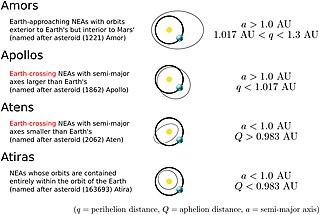Related Research Articles

Atira asteroids or Apohele asteroids, also known as interior-Earth objects (IEOs), are Near-Earth objects whose orbits are entirely confined within Earth's orbit; that is, their orbit has an aphelion smaller than Earth's perihelion, which is 0.983 astronomical units (AU). Atira asteroids are by far the least numerous group of near-Earth objects, compared to the more populous Aten, Apollo and Amor asteroids.

2062 Aten, provisional designation 1976 AA, is a stony sub-kilometer asteroid and namesake of the Aten asteroids, a subgroup of near-Earth objects. The asteroid was named after Aten from Egyptian mythology.
3554 Amun is an Aten asteroid, meaning it crosses Earth's orbit, and a Venus-crosser. It was discovered on 4 March 1986 by Carolyn and Eugene Shoemaker at Mount Palomar Observatory, and named for the ancient Egyptian deity Amun. Amun was the fifth Aten asteroid to be numbered.
(99907) 1989 VA is a very eccentric, stony asteroid and near-Earth object, approximately 1 kilometer in diameter. It was discovered on 2 November 1989, by American astronomer couple Carolyn and Eugene Shoemaker and Canadian astronomer David Levy at the Palomar Observatory on Mount Palomar, California.

524522 Zoozve (provisional designation 2002 VE68) is a sub-kilometer sized asteroid and temporary quasi-satellite of Venus. Discovered in 2002, it was the first such object to be discovered around a major planet in the Solar System. It has nearly the same orbital period around the Sun that Venus does. In a frame of reference rotating with Venus, it appears to travel around it during one Venerean year, but it orbits the Sun, not Venus.

2011 SC191 is a small asteroid and Mars trojan orbiting near the L5 point of Mars (60 degrees behind Mars on its orbit).

2011 SL25, also written as 2011 SL25, is an asteroid and Mars trojan candidate that shares the orbit of the planet Mars at its L5 point.
2012 XE133 is an asteroid, classified as near-Earth object of the Aten group that is a temporary co-orbital of Venus.
2013 BS45 (also written 2013 BS45) is a horseshoe companion to the Earth like 3753 Cruithne. Like Cruithne, it does not orbit the Earth in the normal sense and at times it is on the other side of the Sun, yet it still periodically comes nearer to the Earth in sort of halo orbit before again drifting away. While not a traditional natural satellite, it does not quite have normal heliocentric orbit either and these are sometimes called quasi-satellties or horseshoe orbits.
2013 ND15 (also written 2013 ND15) is an asteroid that is a temporary trojan of Venus, the first known Venus trojan.
2014 OL339 (also written 2014 OL339) is an Aten asteroid that is a temporary quasi-satellite of Earth, the fourth known Earth quasi-satellite.
2013 LX28, is an asteroid, classified as near-Earth object of the Apollo group that is a temporary quasi-satellite of the Earth, the third known Earth quasi-satellite.
2015 SO2 (also written 2015 SO2) is an Aten asteroid that is a temporary horseshoe companion to the Earth, the ninth known Earth horseshoe librator. Prior to its most recent close encounter with our planet (2015 September 30) it was an Apollo asteroid.
2015 XX169 (also written 2015 XX169) is an Apollo asteroid that is a temporary horseshoe companion to the Earth, the tenth known Earth horseshoe librator. A close encounter with the Earth on 14 December 2015 caused the value of the semi-major axis of 2015 XX169 to drift slowly upwards, and the object evolved from an Aten asteroid to an Apollo asteroid about a year after this close approach.
2015 YQ1 (also written 2015 YQ1) is an Apollo asteroid that is a temporary horseshoe companion to the Earth, the twelfth known Earth horseshoe librator. It experienced a close encounter with the Earth on 2015 December 22 at 0.0037 AU.
2015 YA is a sub-kilometer asteroid, classified as near-Earth object of the Aten group, that is a temporary horseshoe companion to the Earth. It is the 11th known Earth horseshoe librator. Prior to a close encounter with the Earth on 15 December 2015, 2015 YA was an Apollo asteroid.

2011 SP189 is a small asteroid and Mars trojan orbiting near the L5 point of Mars (60 degrees behind Mars on its orbit).
2020 VT1 is a small asteroid, classified as a near-Earth object of the Amor group, that is a temporary horseshoe companion to Mars.
2020 PN1 is a sub-kilometer asteroid, classified as a near-Earth object of the Aten group, that is a temporary horseshoe companion to the Earth. There are dozens of known Earth horseshoe librators, some of which switch periodically between the quasi-satellite and the horseshoe co-orbital states.
2020 PP1 is a sub-kilometer asteroid, classified as a near-Earth object of the Apollo group, that is a temporary quasi-satellite of the Earth. There are over a dozen known Earth quasi-satellites, some of which switch periodically between the quasi-satellite and horseshoe co-orbital states.
References
- ↑ List Of Aten Minor Planets
- 1 2 3 "(322756) 2001 CK32". JPL Small-Body Database . Jet Propulsion Laboratory. SPK-ID: 2322756 . Retrieved 8 April 2016.
- ↑ AstDys-2 on 2001 CK32 Retrieved 2012-08-25
- ↑ NEODyS-2 on 2001 CK32 Retrieved 2012-08-25
- ↑ CNEOS – Asteroid Size Estimator
- ↑ Transient co-orbital asteroids
- ↑ de la Fuente Marcos, C.; de la Fuente Marcos, R. (2013). "Asteroid 2012 XE133, a transient companion to Venus". Monthly Notices of the Royal Astronomical Society . 432 (2): 886–893. arXiv: 1303.3705 . Bibcode:2013MNRAS.432..886D. doi:10.1093/mnras/stt454.